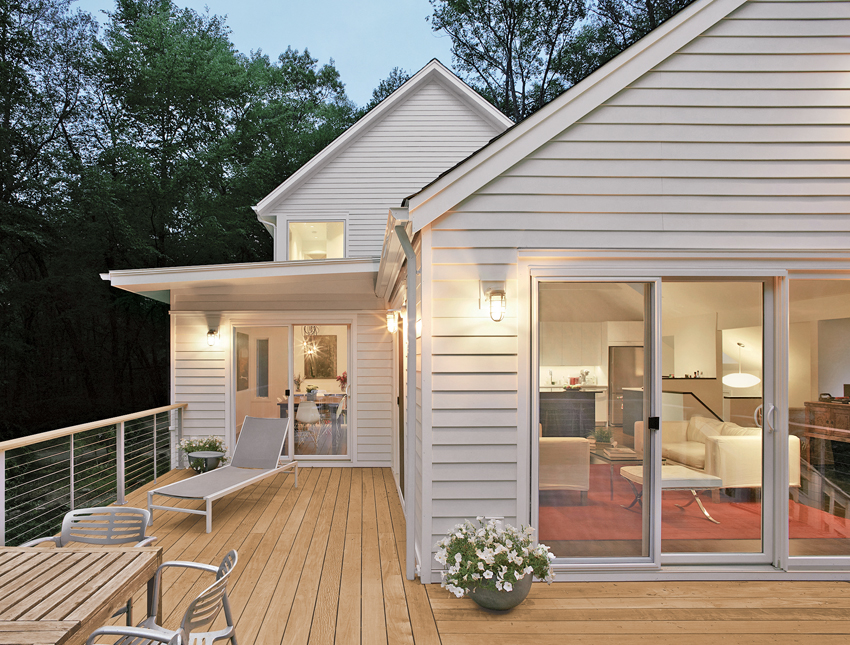Fenestration in single family residences can come in different forms. Instead of relying only on windows, a common alternative is the use of different types of exterior doors that are predominantly made from glass in frames (i.e., side stiles, top and bottom rails) instead of solid, opaque material. The appeal of such glass doors, as we will refer to them in this course, comes from their ability to provide daylight, views, and general connectivity between indoors and outdoors. Furthermore, with different options available for sizes and materials, they can be readily incorporated into a wide range of architectural design aesthetics. To be successful, however, they need to perform as intended for thermal characteristics and air sealing as well as for security and weatherability.
Based on the above, this course looks at the range of available glass door types, their design characteristics, performance considerations, and their potential to contribute to healthier, more appealing spaces. Overall, understanding the various attributes is meant to guide architects when incorporating exterior glass doors into single family residential designs.
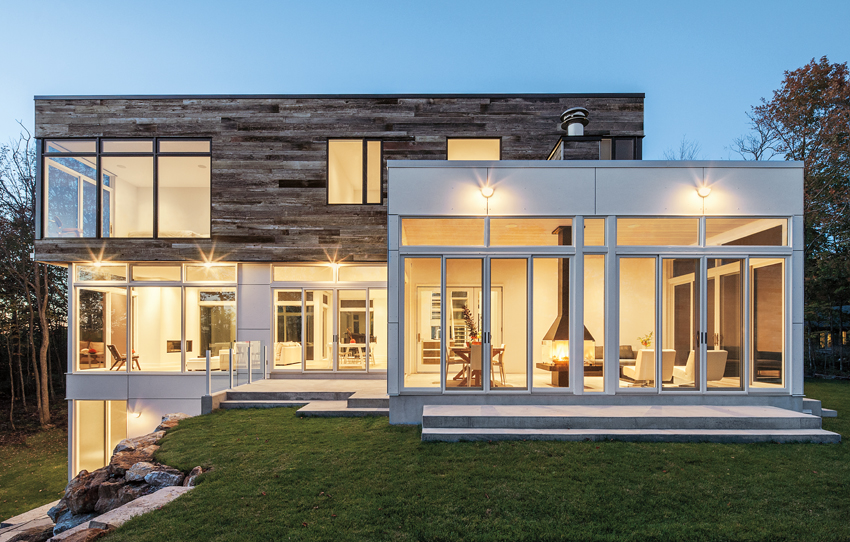
All photos courtesy of Marvin
Residential glass doors are used in many different designs to create vibrant, open, healthy housing options.
Trends in the Use of Residential Exterior Glass Doors
Incorporating windows and doors into residential facades is a fundamental, and often pivotal, part of the design of the building. As such, many different factors can affect the decisions on what windows and doors are ultimately selected and made part of the finished building. Some of those design decisions are based purely on architectural factors related to the design, others are based on requirements of codes and standards, while still others are based on prevailing trends in residential design. Such trends can be market driven or be a response to the preferences and desires of homeowners or homebuilders.
We begin by recognizing some of the factors and trends that are influencing architects and others to look beyond standard windows, and instead consider exterior glass doors as part of their design schemes.
Indoor/Outdoor Living
Outdoor living areas have always been popular in residential design whether that means a defined yard, a patio, a deck, or similar space. In recent years, the design of those spaces has often become more sophisticated and considered more of an extension of the primary residential living spaces. Some are simple landscaped areas, while others have roofed portions that are furnished and fully equipped as outdoor living spaces. Very often, the key to making these spaces work has become the windows and doors that people can use to make the connection between the indoor and outdoor spaces. Exterior glass doors, in particular, have been used successfully for this purpose. When the door is closed, it still provides a visual connection through the use of clear vision glass. When the door is open, it needs to be a large enough passage for people and any other items that are commonly moved through it. Combining the door with other framed glass panels, whether stationary or movable, allows the entire facade to be designed around forging the most appealing, and most user-functional, solution. Overall, the common design goal is to create a strong connection between indoor and outdoor living spaces.

Designing residences with direct connections between the indoors and outdoors is a growing trend that supports homeowner desires and wellness.
General Well-being
A strong design trend in recent years has been to create buildings, including homes, that promote a sense of health and wellness. Many different studies, as well as other research, have confirmed repeatedly what some designers have intuitively suspected – buildings with access to daylight, fresh air, and views of the outdoors all work to promote human well-being. Daylight gives us a reference to time, which affects the natural circadian rhythms of people. It can also brighten our mood, not just the space we are experiencing it in. Fresh air feels and smells different than indoor, conditioned air. That difference is noticeable in many cases and can have a positive impact on people as a result. Having views to the outdoors allows our eyes to readjust to a longer view than we have within the confines of a building or home. Further, if that view includes natural elements such as plants, trees, water, etc., then a biophilic connection is generally deemed to be created. In all, people generally do better in buildings that provide light, air, and views than those that deprive or limit those natural attributes. The design and construction response to recognizing this condition is to add windows and doors with clear glass and configurations that allow for their proper opening and closing.
Pandemic Influences
The COVID-19 pandemic and associated work restrictions created a dramatic surge of interest in home designs – both new and renovation. For many people, the new-found reality of spending much more time at home instead of at work or out in public places motivated many to make changes in the places where they live. Some of those changes were based on the need to have adults working from home, school children learning from home, or a mix of people simply doing more things from home than was previously typical. The use of rooms and spaces became redefined in many cases as dining rooms became work rooms, spare bedrooms became home offices, or any space became a place to open up a laptop computer. In some cases, the changes were simple, while in others, the best solution was to move to a new home altogether, particularly if proximity to a central work location was no longer important.
irectly related to these space use changes, the quality of those spaces became more important. The size and configuration of the most-used spaces was more critically reviewed but so was the overall design character. Is there enough daylight, air, and view? Can I easily get to the outside for a break, or even work outside if the weather warrants it? The incorporation of exterior glass doors into residences helped to answer all these questions related to an altered lifestyle. While many people assumed that some of these lifestyle changes would be temporary, others have made longer-lasting changes such that the issues related to residential design are likely to remain for some time.
Clean Aesthetic
Housing design in the United States is certainly varied in styles, types, and character. Nonetheless, when it comes to windows and doors, the general trend is for manufacturers to provide products that bring a simple, visually clean aesthetic to a building. That allows the home designer to decide if the windows and doors are enhanced with additional detail, as might be common in traditional designs, or to be left simple and elegant, as is common in modern or contemporary design styles. Glass exterior doors fit directly into this trend with manufacturers offering products with refined door sash and frame in a variety of options. Some standard products have thicker stiles or frames around the glass to blend with traditional looking opaque doors. Others have engineered frames that are thin and narrow, allowing the glass area to be the dominant feature of the door. In that case, a minimalist look is achieved that allows the door unit to be visually subordinate to the surrounding building elements. In all cases, the clean-looking aesthetic of glass exterior doors can be used to blend with any housing style or type. Part of the appeal of glass exterior doors are the multiple design options - there are so many more choices than just a singular panel. Architects can choose from large sizes, different configurations, a variety of operation styles, etc. With this expanded range of design features and options, architects benefit from fewer restrictions to deliver a design best suited to their clients’ needs and lifestyles.
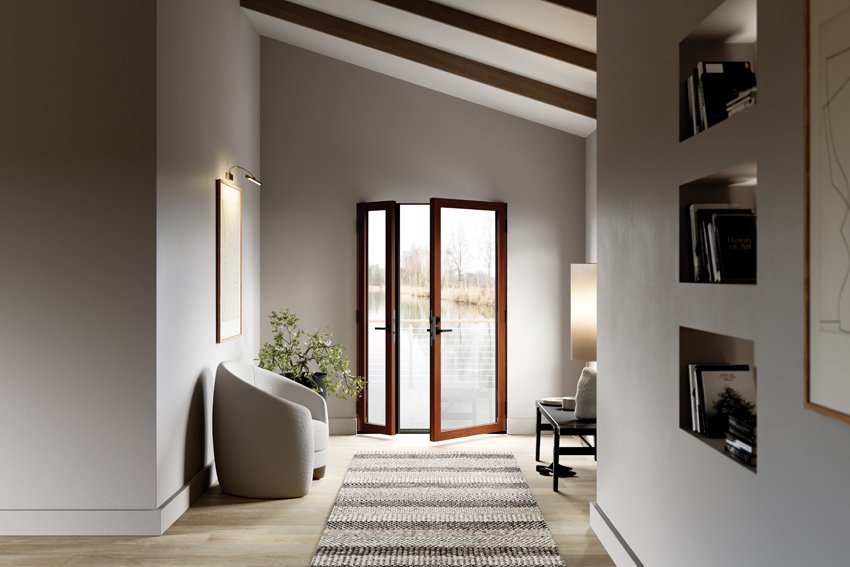
There is growing demand for products that bring a visually clean aesthetic to a building.
Entry Door Systems
Primary entrance doors to residences are often a focal point of a facade design. The selection of the style and material of those doors is often based on compatibility or enhancement of the building design. As such, residential designs that favor large glass openings and more contemporary appearances are prone to use large exterior glass doors for the entry. The type or style of operation may vary, but manufacturers offer some options, particularly in regard to size, that can enhance the overall design. For example, some manufacturers offer exterior glass doors within a standard size matrix of 10- or 12-feet heights. This can eliminate the need for transoms above the door and better align with window layouts.
Larger Sizing
In addition to taller entrance doors, manufacturers now offer larger sizes for all types of glass doors, both in terms of width and height. In particular, larger panels of framed glass are being combined in a variety of ways that fold, slide, or retract to the point that such doors essentially become movable glass walls. This trend goes hand in hand with some of the other trends above, particularly the desire to create smooth transitions between indoor and outdoor spaces. The panel size widths and heights can vary but there are usually practical limits based on the weight of the glass and code requirements for the maximum area of tempered glass, etc. Working directly with manufacturers to identify options, limitations, and opportunities for better design solutions makes the most sense in this case.
Door Selection and Design Considerations
Glass exterior doors have emerged as a key design element in residential architecture in virtually all regions and locations across the United States and Canada. From the classic suburban sliding patio door to the range of glass entry doors to the use of large operable glass walls, these doors are integral, and often central, to many residential designs.
In order to better understand how glass exterior doors are integrated into a project, the best place to start is by looking at the different fundamental types. Each of the doors described in the following sections have a specific method of operating which has implications for the space needed for their operation so that people and objects can pass through them. As will become apparent, there are glass door styles and types to fit a variety of design criteria and occupant desires.
Swinging Doors
There are three common types of doors that operate by swinging open and closed.
- Hinged doors are the most common style of door. They are often used in conjunction with large doors or movable walls for everyday use and ease of access. Another option within the hinged doors category is a bi-folding door. They feature panels that can be solid or glazed and swing open and closed by virtue of hinge hardware. Hinged doors can be a single panel or be paired into a double panel – commonly hinged on the outer sides and meeting in the middle. For each panel, the direction that it swings, either to the right or the left, is called the handing. In addition to handing, exterior swing doors are identified as either inswing or outswing depending on whether they open into the house or towards the outside.
- Entry doors are typically manufactured as a specific type of swinging hinged door to act as a primary passage between a house and an outdoor space. As a hinged door, they typically feature one or multiple panels that swing open and closed as described above. Entry doors are commonly made of wood, fiberglass, composite, aluminum, or steel and may or may not have glass. Consistent with what we have discussed so far, however, it is very common to find fully glazed doors with many choices in the geometry and layout of the glass within the door unit. Unlike interior swinging doors, entry doors have weatherstripping and a threshold, which provide protection from weather conditions. The ability of swinging entry doors to resist weather, water, wind, etc., can vary quite a bit based on the design and makeup of the weatherstripping and threshold. Therefore, it is common to provide an overhang or porch-like protection for such doors to help with weather resistance. Swinging entry doors are also commonly intended to be used with security hardware such as keyed locks and deadbolts. Entry doors are commonly manufactured in standard sizes as well as larger. Any of them can be used alone or be combined with transom and sidelight windows to accommodate an overall design scheme for a main entry.
- Pivot doors are swinging doors that use a different type of hardware to operate. Instead of side mounted hinges, rods or metal extensions extend from the top and bottom of the door to fit into the door head and sill. This hardware is offset from the swinging end and is well-suited for very large openings, up to 6 feet wide and 10 feet tall. This can make a dramatic statement when the door is opened as the door panel appears to hover and be disconnected from the frame. Properly installed, they are easy to operate and offer some uniqueness. They can use standard locking hardware or multi-point internal security hardware.
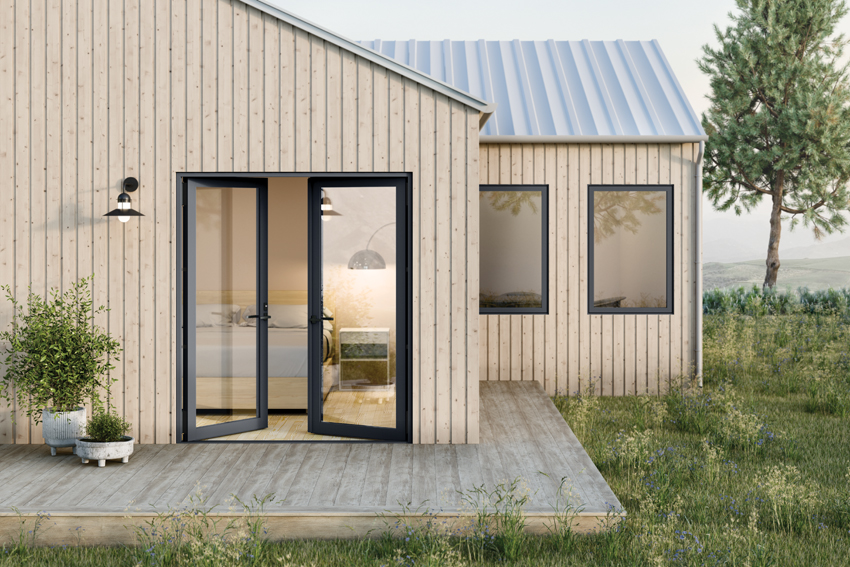
Swinging exterior glass doors are available in single or multiple panel designs.
Sliding Doors
A very common alternative to swinging doors is to use door panels that are designed and manufactured into a frame which allows them to slide back and forth. This type eliminates the need for square footage to allow for the door swing but does require a location for the sliding panel(s) to move to. The hardware for almost all types of sliding doors is supplied and pre-installed by the door manufacturer. This is primarily done to be sure the door works properly and that the hardware doesn’t interfere with the sliding operation. There are usually some options to choose from in terms of style, color, and quality.
There are four types of sliding exterior doors commonly available and in widespread use, described further as follows:
- Patio doors are the most common and perhaps best-known type of sliding glass exterior door. They typically have one or more door panels that open by either gliding on a track at the sill or hanging from rollers mounted above. The sliding panel most commonly moves to one side or the other and covers over a fixed panel, such that the two panels line up or stack in front of each other when the door is fully open. Unlike swinging doors, which require space to be set aside for the door panel to open, furniture and other household items can be placed near this type of door, particularly by the fixed panel as long as it doesn’t interfere with the movement of the sliding panel. Patio door sizes commonly match swinging door sizes and are usually easy to coordinate with transoms if desired or to align with windows in a home design. They can also use multi-panel configurations using both operating and stationary panels.

Sliding exterior glass doors are available in many sizes, shapes, and configurations.
- Lift and slide doors are a variation on patio doors. Instead of a simple track system, lift and slide doors use large door panels with an engineered carriage system and hardware that lifts panels up off their track as they are opened or closed. This carriage system produces a near weightless operation even with large panels. Lift and slide doors are commonly available with panel sizes up to 6 feet wide and 12 feet high and a total door system that can span up to 47 feet in width. Different panel configurations can be selected to best suit the layout of a room in terms of the location of fixed and moving panels. Note that the panels can be moved into a wall pocket specifically designed for that purpose which will directly affect the design and construction of that wall. Also note that the sill for lift and slide doors can also be either raised or flush. The raised sill typically provides better protection against air and water infiltration due to direct environmental exposure. A recessed sill can create a smoother transition between indoors and outdoors.

Multi-slide doors allow for multiple panels to move along a single, multiple channel track.
- Multi-slide doors have more than one moving panel aligned in a total door system. Using a multi-slotted track, multiple panels slide past each other to stack on one end. Those stacked panels can remain visible over a stationary panel, or all of the panels can be recessed into a wall pocket sized to accommodate them. The operation is usually done manually with minimal effort, although some multi-slide doors are available with push-button motorized operation.
- Bi-fold doors, also called folding doors or accordion doors, are comprised of multiple panels that slide to one side or the other, (or both) but have hinges connecting the panels together. That means that in the process of sliding the end panel to open the door, the other panels fold along the hinges. When fully opened, the panels then stack so they are perpendicular to the opening, not parallel, as in other sliding door systems. One attribute of bi-fold doors is the availability to fill a large opening with a number of panels without affecting the jamb depth or wall thickness.
All the door types described can be customized using different finishes for the stiles and rails, different glass types, and different panel designs, particularly for divided lites. Manufacturers also offer a choice in the width of stiles and rails – 6-inch being common for traditional looks and 3 - 4-inch or so used for more contemporary appearances.
Functionality and Performance Considerations
The means for achieving a desired level of functionality or performance for any specific exterior glass door is not limited to any one feature or component. Rather, it is the total performance achieved by looking at all of the various parts of a glass door. The relevant points are summarized as follows.
- Door Frames Most swinging glass doors are pre-hung on a frame while sliding doors are inserted into a large frame. It is this frame that provides the structural integrity for the total door unit to operate freely once it is attached to the adjacent construction. The integrity of the framed opening, however, is dependent on the engineered framing of that opening and needs to be addressed properly by the architect or engineer for any given project in order to avoid sagging and interference with proper door operation. Part of the integrity of the manufactured frame comes from the materials used for the frame and their own engineered design. Typically, the frame material matches the door panel material and its appearance. There are different choices which are often selected based on the project conditions, the level of durability needed, and other design and performance requirements. For residences, the common choices include wood, aluminum clad wood, extruded aluminum, or fiberglass. The particular details of each of these choices should be reviewed based on manufacturers’ information to be sure that the attributes of individual door frame products are understood.
- Glass and Glazing Glass and glazing systems have developed and advanced in recent decades to respond to different needs. From a design standpoint, the glass used in windows and doors can be specified to be clear, tinted, or obscure to suit different uses and needs for privacy. In terms of performance, considerable attention has been paid to enhancements to the glass which improve energy performance. Coatings that reflect or absorb heat and ultraviolet light (UV) can be selected depending on the need with different degrees of performance available. Insulated glass units (IGUs) with two layers of glass are common and allow for the coatings to be placed on the most appropriate inside or outside surfaces of that glass. In cases where higher performance is desired, triple-glazed units are also possible. Beyond the glass itself, however, other components have also been optimized. High-performance spacers between the panes of glass reduce the heat flow there. Attention to proper air sealing of the windows or doors reduces unwanted air infiltration helping with overall performance. In all, options are available that allow the architect or designer to specify the most appropriate choices for design and performance to meet the requirements of codes or goals of the project.
- Sills Door sills are a key performance consideration for water management. Swinging doors require different types of sills than sliding doors but the details and configuration of each need to work with the door panel to achieve the needed level of protection. In cases where lower levels of water and weather protection are needed, then a flush sill is possible. In cases where higher levels of protection are needed (i.e., the door is fully exposed on the exterior) then the manufacturer's choices should be reviewed for both leakage resistance and proper drainage. It is worth noting that in some cases, the sills for sliding doors actually have greater performance results than sills or thresholds for swinging doors.
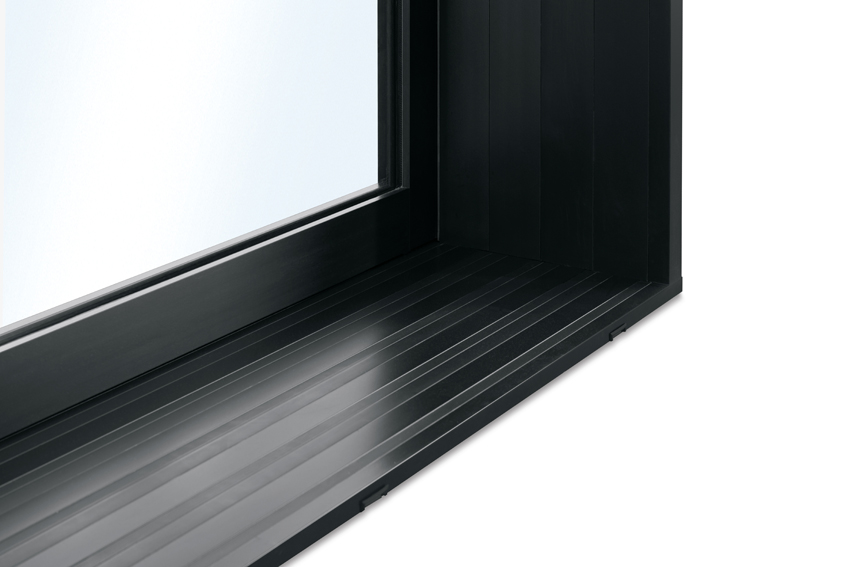
Different types and configurations of sills can be selected based on the degree of weather resistance and performance
desired or required.
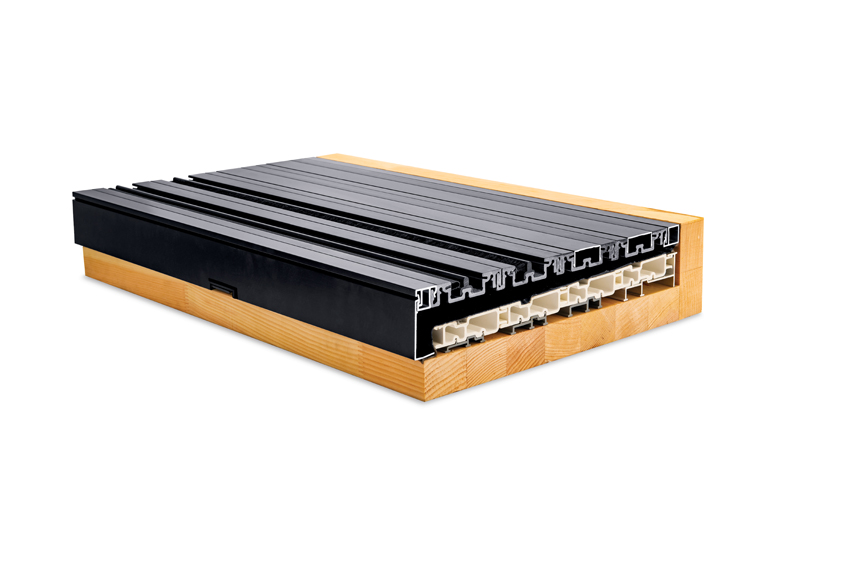
- Weatherstripping The weatherstripping around a door provides the seal around the perimeter of the door when it is closed. It is typically provided as an integral component of the door and/or frame to address air and water infiltration along with energy performance. The choices here should be directly compatible with the type of door being used. Some are based on compressing seals which works well for swinging doors. Others are based on overlapping materials which is better suited to sliding doors.
- Screens Part of the original design consideration for many architects is the need for insect screens to be included for all operable openings, including exterior glass doors. Manufacturers have responded with several options related to the type of glass door being used. Sliding patio doors commonly have full panel sized sliding screens that move from side to side. Swinging doors can utilize either the same type of sliding screens or swinging screen doors can operate opposite the swinging door (i.e., inward swinging door with outward swinging screen). The larger, multi-panel doors may be able to be equipped with retractable screens which roll out of sight when not in use and are pulled across the opening when needed.
- Locks and Hardware For most exterior glass doors, the locks and hardware are provided by the door manufacturers and pre-installed. In some swinging door cases, there may be the option to use some available residential door hardware. Either way, the proper selection of hardware is important for the smooth operation of the doors. This is especially true as the size and weight of the door panels increases – bigger doors mean more force and stress on the hardware and its attachments. Hence the size of the hardware, the thickness of the materials, the functionality of moving parts, and the overall durability of the hardware all need to be matched with the particular door and conditions. There are of course options available for the style and finish of the hardware used available from manufacturers. Specialty hardware may also be an option such as a concealed, multi-point locking system. Further, adjustable hinges may be an option to accommodate building settling or creep over time.
- Standards Glass doors can generally be evaluated by most of the same third-party independent testing standards as for windows. These include comprehensive testing by the National Fenestration Rating Council (NFRC) which identifies the total energy performance of tested units for heat transfer (U-factor), solar heat gain, visible light transmission, air infiltration, and condensation resistance. It also includes the Fenestration and Glazing Industry Alliance (FGIA), which is a recent collaboration of the American Architectural Manufacturers Association (AAMA) and the Insulating Glass Manufacturers Alliance (IGMA). The FGIA now provides standard testing and standards for all types of windows and doors. Finally, there is also ASTM International, which has developed numerous tests for different types of glass, glazing systems, and window and door products. All of these are relevant performance standards for exterior glass doors of all types, just as they are to windows and similar fenestration.
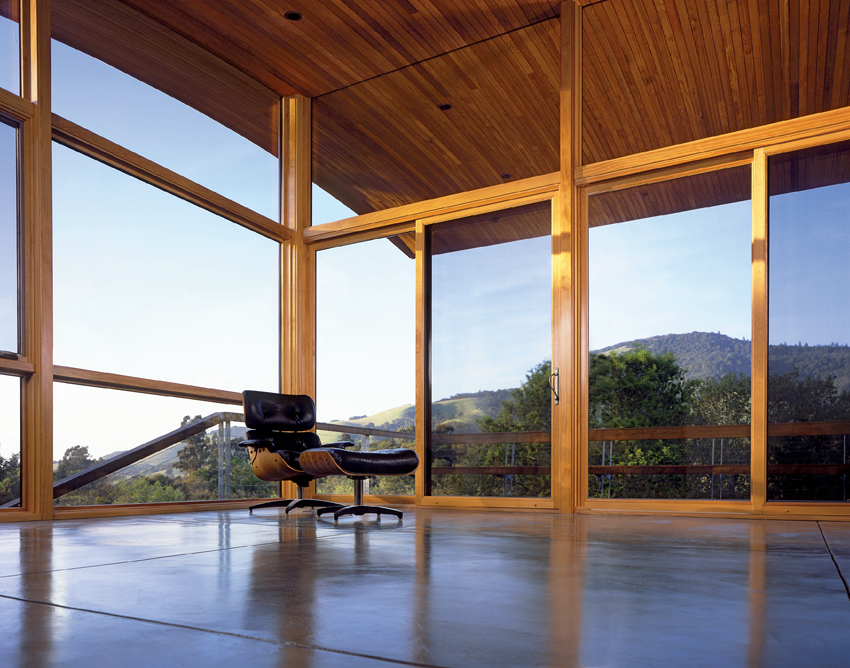
The performance of exterior glass doors is based on attention to the different elements, including the availability of insect screening as shown here.
Other Considerations of Exterior Glass Doors
Beyond the specific design and performance attributes of using glass doors in residences, there are some other common considerations that often come into play.
Well-Being
Exterior glass doors directly address some of the trends noted at the beginning of this course, particularly related to the general well-being of the occupants in the home. As people have found themselves spending more time in their homes, it is quite predictable that they would want to feel healthy, safe, and secure, especially with the influence of the recent pandemic. It is also reasonable that the trend of indoor/outdoor connectivity is reinforced by these feelings as people don’t want to feel boxed in or isolated but would benefit instead by some connectivity to the surrounding area. Exterior glass doors, of all types, contribute to these well-being needs, first by providing more daylight to a home. Sleep scientists understand that natural light promotes daily rhythm, which can help regulate hormonal balance, appetite, sleep, productivity, and energy levels, thereby impacting not only physical health but also emotional and social well-being. Similarly, views of the outside world are known to help create a sense of place and calm, particularly if there are elements of the natural environment involved such as trees or water. Such connections are attributed to building a sense of optimism, boost moods, and provide energy for better living. Finally, operable exterior glass doors can provide an abundance of fresh air to a home. Not only is there the direct benefit of enjoying the outdoor air, circulating fresh air helps reduce levels of indoor pollutants like volatile organic compounds (VOCs), ozone, radon, and carbon monoxide that may be present in the home. In all, the use of glass doors, can be a key design element in providing a sense of healthy living and wellness in many different types of residential designs.
Overcoming Misperceptions
Sometimes there is a reluctance to consider exterior glass doors on the part of designers or homeowners because of misperceptions about their applicability or functionality. Here are a few points to set the record straight:
- The design and functional benefits of glass doors are not just for large homes with big budgets and grand views. Rather, they are being readily incorporated into residential projects of all types - small spaces, remodeled spaces, urban settings, new construction, etc. They contribute to whatever setting and budget a particular project brings.
- Doors that are very traditional in nature, such as round-top French doors, as well as contemporary styles, have been updated by manufacturers to create improved sightlines and a clean aesthetic. Therefore, instead of looking bulky or heavy, they can look lighter and more consistent with the rest of the fenestration in the house.
- Proper operation of the doors is more dependent on the hardware and track than on the door panel itself. That means paying attention to the best pairing of these items with the size and shape of the door panels is important for good, long-lasting operation.
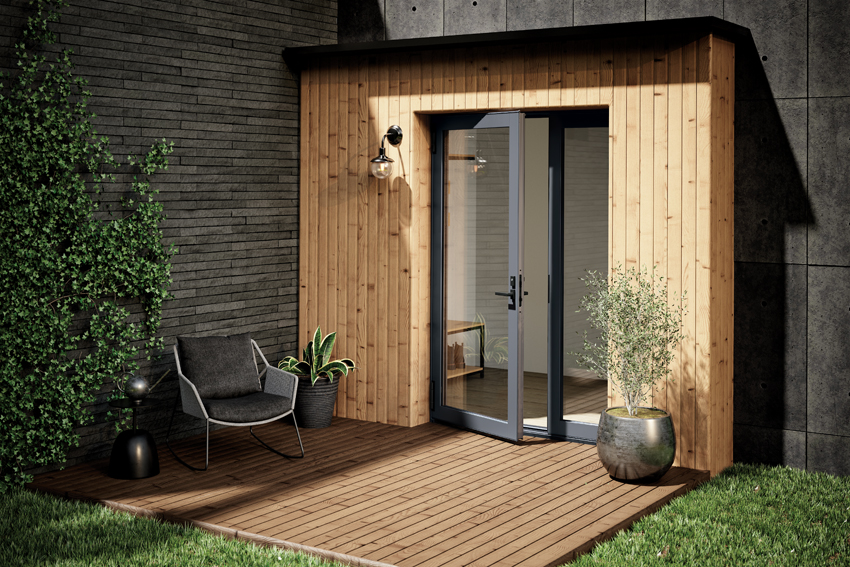
Exterior glass doors can be used in smaller, focused spaces as well as larger spaces.
Conclusion
Residential exterior glass doors have been shown as a desirable option for fenestration in many different project types. They can contribute to more attractive, flexible spaces that are open and inviting, consistent with many current residential design trends. They are available in a range of types and sizes that can enhance and complement a particular design. Their performance is based on attention to the different components and elements such that they all work together for a total solution. By recognizing how they contribute to occupant wellness and by overcoming misperceptions about their use, architects can use glass doors to create very successful residential design projects. Michael Wandschneider, senior product portfolio strategist with Marvin Windows and Doors, sums it up this way: “The needs of homeowners and architects have steadily evolved in the last few years, and we’ve seen that reflected in the demand for large glass exterior doors in residential design. Such products are essentially movable walls of glass that can completely transform spaces so that there’s a seamless flow between indoors and outdoors. What’s more, they’re easy to use with great performance. We’re only going to see a more accelerated use of big doors like these in the home."
Peter J. Arsenault, FAIA, NCARB, LEED-AP is a nationally known architect and a prolific author advancing sustainable residences through better design.www.pjaarch.com, www.linkedin.com/in/pjaarch











